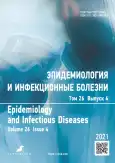Difficulties of diagnosis and management tactics of COVID-19 in HIV-infected patients in a non-infectious hospital
- Authors: Nagibina M.V.1, Sycheva A.S.1, Solodov A.A.1, Kebina A.L.1, Malyavina M.A.1, Tebueva L.V.1, Tuglanova B.M.1
-
Affiliations:
- Moscow State University of Medicine and Dentistry named after A.I. Evdokimov
- Issue: Vol 26, No 4 (2021)
- Pages: 187-195
- Section: Case reports
- Submitted: 29.06.2022
- Accepted: 07.07.2022
- Published: 29.07.2022
- URL: https://rjeid.com/1560-9529/article/view/109073
- DOI: https://doi.org/10.17816/EID109073
- ID: 109073
Cite item
Abstract
The spread of COVID-19 over the past three years has posed difficult tasks for doctors related to rapid diagnosis and provision of highly qualified medical care to patients, including with co-infection ― SARS-CoV-2/human immunodeficiency virus.
The analysis of the combined course of COVID-19 and human immunodeficiency virus demonstrated the synergistic effect of SARS-CoV-2 and human immunodeficiency virus on the human body. Numerous studies have shown that COVID-19 is more severe and is accompanied by high mortality in older people and in the presence of comorbid pathology. Including important role belongs to diseases accompanied by suppression of cellular immunity, which lead to frequent complications and longer viremia, which can be observed with human immunodeficiency virus infection. The similarity of clinical, laboratory and radiological data does not allow to differentiate COVID-19 and human immunodeficiency virus opportunistic diseases with lung damage (pneumocystic pneumonia, cytomegalovirus and candidiasis etiology), in an early period, especially in patients without an established human immunodeficiency virus status.
Identification of the features of the course of the disease, alertness towards human immunodeficiency virus infection in patients admitted to the hospital with COVID-19 at a young age, the peculiarities of the epidemiological history will allow early diagnosis and improve management tactics.
Full Text
About the authors
Margarita V. Nagibina
Moscow State University of Medicine and Dentistry named after A.I. Evdokimov
Author for correspondence.
Email: infektor03@gmail.com
ORCID iD: 0000-0001-5327-9824
SPIN-code: 6779-9405
MD, Dr. Sci. (Med.), Professor
Russian Federation, 20/1, Delegatskaya street, Moscow, 127473Aleksandra S. Sycheva
Moscow State University of Medicine and Dentistry named after A.I. Evdokimov
Email: docsycheva@gmail.com
ORCID iD: 0000-0001-8804-9914
SPIN-code: 7563-0151
MD
Russian Federation, 20/1, Delegatskaya street, Moscow, 127473Alexander A. Solodov
Moscow State University of Medicine and Dentistry named after A.I. Evdokimov
Email: docsol@mail.ru
ORCID iD: 0000-0002-8263-1433
SPIN-code: 6946-8672
MD, Dr. Sci. (Med.), Professor
Russian Federation, 20/1, Delegatskaya street, Moscow, 127473Anastasia L. Kebina
Moscow State University of Medicine and Dentistry named after A.I. Evdokimov
Email: akebina@list.ru
ORCID iD: 0000-0002-7570-9650
SPIN-code: 1173-3423
Assistant
Russian Federation, 20/1, Delegatskaya street, Moscow, 127473Maria A. Malyavina
Moscow State University of Medicine and Dentistry named after A.I. Evdokimov
Email: mari_malyavina173@mail.ru
ORCID iD: 0000-0002-7500-110X
MD
Russian Federation, 20/1, Delegatskaya street, Moscow, 127473Lyuaza V. Tebueva
Moscow State University of Medicine and Dentistry named after A.I. Evdokimov
Email: Lyuaza.tebueva@mail.ru
ORCID iD: 0000-0002-0818-8330
Student
Russian Federation, 20/1, Delegatskaya street, Moscow, 127473Bela M. Tuglanova
Moscow State University of Medicine and Dentistry named after A.I. Evdokimov
Email: tuglanova13@rambler.ru
ORCID iD: 0000-0002-5654-7692
MD
Russian Federation, 20/1, Delegatskaya street, Moscow, 127473References
- Yang J, Zheng Y, Gou X, et al. Prevalence of comorbidities in the novel Wuhan coronavirus (COVID-19) infection: a systematic review and meta-analysis. Int J Infect Dis. 2020;94:91–95. doi: 10.1016/j.ijid.2020.03.017
- Wang D, Hu B, Hu C, et al. Clinical characteristics of 138 hospitalized patients with 2019 novel coronavirus-infected pneumonia in Wuhan, China. JAMA. 2020;17(323):1061–1069. doi: 10.1001/jama.2020.1585
- Lee KW, Yap SF, Ngeow YF, Lye MS. COVID-19 in people living with HIV: a systematic review and meta-analysis. Int J Environ Res Public Health. 2021;18(7):3554. doi: 10.3390/ijerph18073554
- Dolgova NN, Ryndich AA, Suladze AG, et al. Some clinical and epidemiological aspects of COVID-19 in people living with HIV. Infectious diseases: news, opinions, training. 2022;11(1):41–46. (In Russ). doi: 10.33029/2305-3496-2022-11-1-41-46
- Mazus AI, Nagibina MV, Bessarab TP, et al. COVID-19/HIV co-infection: characteristics of patients of the Moscow megalopolis. Therapy. 2021;7(4):18–24. (In Russ). doi: 10.18565/therapy.2021.4.18-24
- Blanco JL, Reyes-Urueña JM, Sued O, et al. Overview of SARS-CoV-2 infection in adults living with HIV. Lancet HIV. 2021;8(5):e294–e305. doi: 10.1016/S2352-3018(21)00070-9
- Sergevnin VI, Sarmometov EV, Rozhkova MV. Prevalence and severity of the clinical course of a new coronavirus infection among HIV-infected people in comparison with the general population. Epidemiology and Vaccination Prevention. 2021;20(3):30–36. (In Russ). doi: 10.31631/2073-3046-2021-20-3-30-36
- Vizcarra P, Pérez-Elías M, Quereda C, et al. Description of COVID-19 in HIV-infected individuals: a single-centre, prospective cohort. Lancet HIV. 2020;7(8):554–564. doi: 10.1016/S2352-3018(20)30164
- Mirzaei H, McFarland W, Karamouzian M, Sharifi H. COVID-19 among people living with HIV: a systematic review. AIDS Behav. 2021;25(1):85–92. doi: 10.1007/s10461-020-02983-2
Supplementary files









